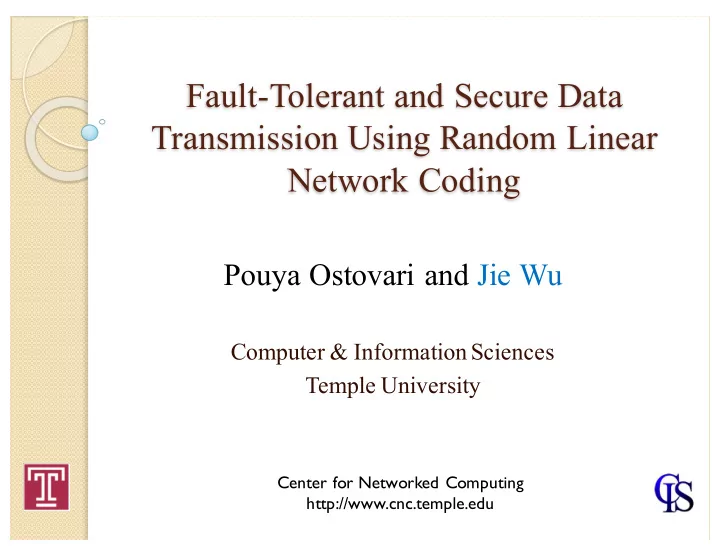

Fault-Tolerant and Secure Data Transmission Using Random Linear Network Coding Pouya Ostovari and Jie Wu Computer & Information Sciences Temple University Center for Networked Computing http://www.cnc.temple.edu
Agenda Introduction ◦ Multi-path network coding ◦ Fault tolerance and security Fault-tolerant and secure data transmission ◦ Problem definition ◦ Problem formulation Evaluations Conclusions 2
Introduction Multi-path transmission ◦ Fault tolerance (FT) via redundancy Transmitting data through multiple paths Paths with different reliabilities More redundancy increases FT, but increases the cost as well ◦ Security Encryption, public/private keys Overhead of encryption methods 3
Network Coding No coding Coding Source XOR network coding Single multicast Two packets • Two destinations • 𝑒 " and 𝑒 # Capacity of each • link: one packet Destinatinos 4
Simple System Setting 𝜗 1 𝛷 1 Transmission a file with m packets 𝜗 2 𝛷 2 s d via n disjoint paths ... 𝜗 𝑜 𝛷 𝑜 Path failure model ◦ If a path fails, all of the transmitted packets over that path fail Eavesdropper probability: fixed ◦ e.g. in wireless networks depends on location of the eavesdropper Objective ◦ Balance fault tolerance and security 5
Linear Coding Failure prob. Eavesdropping Random linear network coding prob. ◦ Linear combinations of the packets 𝑟 " = 𝛽 "," 𝑞 " + 𝛽 ",# 𝑞 # + 𝛽 ",6 𝑞 6 𝜗 1 𝛷 1 𝑟 # = 𝛽 #," 𝑞 " + 𝛽 #,# 𝑞 # + 𝛽 #,6 𝑞 6 𝜗 2 𝛷 2 s d … ... 𝑟 7 = 𝛽 8," 𝑞 " + 𝛽 8,# 𝑞 # + 𝛽 7,6 𝑞 6 𝜗 𝑜 𝛷 𝑜 ◦ m=3 linearly independent coded packets are sufficient for decoding, using Gaussian elimination If we code m packets, eavesdropper/destination needs m coded packets to retrieve the original packets m and n can be different numbers 6
Fault Tolerance and Security FT ◦ m linearly independent coded packets are sufficient for retrieving the original data Security ◦ Eavesdropper cannot decode the coded packets unless it has m linearly independent packets Challenge More transmitted coded packets More robust More vulnerable against failures against eavesdropping 7
Problem Formulation With n paths, there are 2 : possible failure/eavesdropping cases ◦ 𝑺 𝒌 : s et of paths that do not fail ◦ 𝑻 𝒌 : set of overheared paths by eavesdropper Failure prob. of 𝑗 th path the path 𝑒 H Prob. of paths in set not to fail and the rest fail Prob. that an eavesdropper has only access to data transmitted on the set of paths in Eavesdropping prob. of the i th path 8
Problem Formulation- Case 1 Objective function as a function of FT and security. ◦ 𝒚 𝒋 : rate of transmitted packets over path 𝑒 H ◦ Sum of 𝑦 H can be greater than 1 ◦ R and S: power set of the paths Vulnerability Reliability Weighted sum 𝒛 𝒌 : Boolean variable to show if packets transmitted over paths in Rj suffice for decoding by destination 𝒜 𝒌 : Boolean variable to show if packets transmitted over paths in Sj suffice for decoding by eavesdropper 9
Problem Formulation- Case 2 We set reliability threshold as a constraint. We then minimize the eavesdropping probability. Minimizing prob. of successful eavesdropping Reliability threshold t 10
Problem Formulation- Case 3 This is the reverse of Case 2. ◦ We set eavesdropping prob. threshold as a constraint. ◦ We maximize the reliability. Maximizing the reliability Security threshold t 11
Relaxation to Linear Programming, Case 1 (LP) NP-complete ◦ mixed integer and linear programming optimizations Modifying the integer variables to real variables Relaxing integer variables to real 12
Heuristic Solution- HR Complexity of the relaxed linear programming ◦ Liner to the number of variables and constraints ◦ With n paths, there are 2 : possible failure/eavesdropping cases Heuristic ◦ Distribution of the transmissions proportional to the failure rate and eavesdropping prob. of the paths Punishment Reward Reliability of the Eavesdropping prob. i th path of the i th path 13
Evaluations Simulator in Matlab environment We use Linprog tool of Matlab to find the solution of the optimizations 100 simulation runs Two settings ◦ LP- n : relaxed optimization case 1(linear programming) with n paths ◦ HR- n : heuristic solution with n paths 14
Evaluations- FT Path failure prob. of each path: [0,0.1] Eavesdropping prob. of each path: [0,0.3] Reliability of heuristic (HR) is close to LP HR over-estimates the reliability More paths enhances the reliability 15
Evaluations- Security Security of HR is close to LP HR under-estimates the security More paths reduces the security 16
Evaluations- Utility The utility of HR and LP is close More paths reduces utility (because of the higher eavesdropping prob. selected compared to the path failure prob.) 17
Future Work Using the idea of critical path ◦ Finding a critical path in a general graph Impact of multi-path on FT and security ◦ More realistic and heterogeneous prob. distributions Impact of correlation ◦ Failure prob. and eavesdropping prob. 18
Thank you 19
Recommend
More recommend